If you do much riding outside the arena, you know it’s inevitable that you’ll encounter water sooner or later. Whether it be a puddle, stream, pond or river, crossing that water is an essential skill for a reliable trail horse. So how do you prepare your horse? We turned to horseman Jonathan Field, a popular trainer and clinician based in British Columbia, Canada, to learn his step-by-step approach to water crossing.
Keep in mind, you can’t expect to your horse to jump into water when you first introduce it. There must be preparation time beforehand, and the horse needs to develop trust in you. He should have mastered basic training and must respect your personal space.
As the rider, you also have to be patient and give the horse time to think. This is crucial if the horse is to be successful at crossing water—or anything else, for that matter.
“I know my horse is ready to be introduced to water crossing when I have his respect going forward over or through obstacles, both in ground training and while riding,” says Field. “Then I will begin small water challenges.
“I teach horses to cross tarps, go over bridges, and all kinds of obstacles in both my ground training and riding training programs,” he adds. “I want them to become confident that they will be safe wherever I send them. Then I have a much better chance of it working without issues when I approach a water crossing.”
Your horse is not ready to attempt water if he’s still anxious, runs to the side, and doesn’t trust you with simple tasks, such as crossing a tarp on the ground.
Begin Desensitizing Your Horse to Water
Access to a creek or pond isn’t always available. You may have to create a puddle to begin introducing your horse to crossing water. The key is to do this before you’re out riding with a group and come across water on the trail.
You may think a 2-inch deep puddle isn’t sufficient to start with, but it’s more than adequate. This is because a horse’s depth perception is different than a human’s.
“That’s why they’ll want to avoid even a small puddle,” says Field. “The other reason is that it’s black and it just sits still. It’s out of context for them. Is it going to jump at them? Is it an endless hole? They might just be thinking, why step in it when we can go around? It’s difficult for them to judge that it’s safe.”
You want to control as much of the scenario as possible the first times your horse encounters water, so be prepared to make your own “water crossing” in a place where your horse is comfortable. Your home arena or stable yard is a good location.
To build trust, Field always starts on the ground, using obstacles in an arena before introducing water. This approach can be used with any horse, but it may take more time if your horse was forced to cross water in the past. If your horse has previous bad experiences with water, use these steps to create a fresh start and new way of thinking.
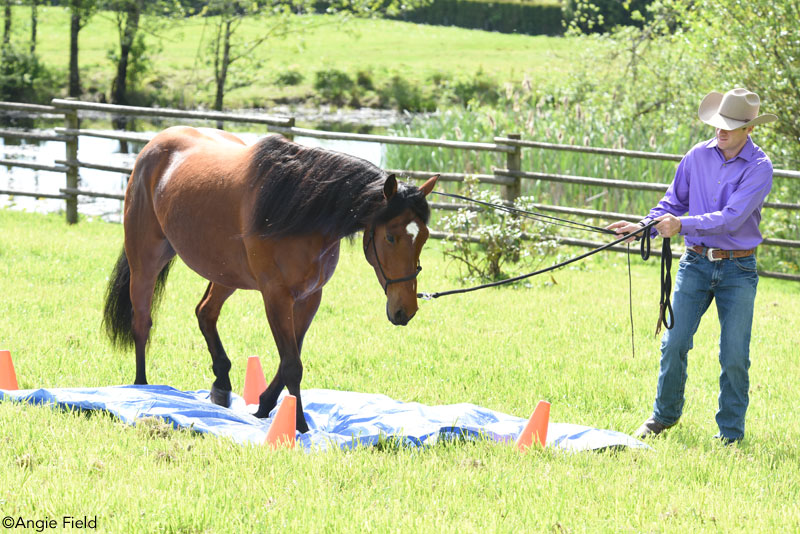
STEP 1: Ground Training without Water
The goal is to teach the horse he’ll be safe wherever you ask him to go. With the horse on a long lead or longeline, direct him over obstacles, such as a tarp on the ground. Be sure to reinforce that he maintain a personal space distance of at least 4 feet from you. This is important because when you do introduce water, you don’t want him to jump on top of you.
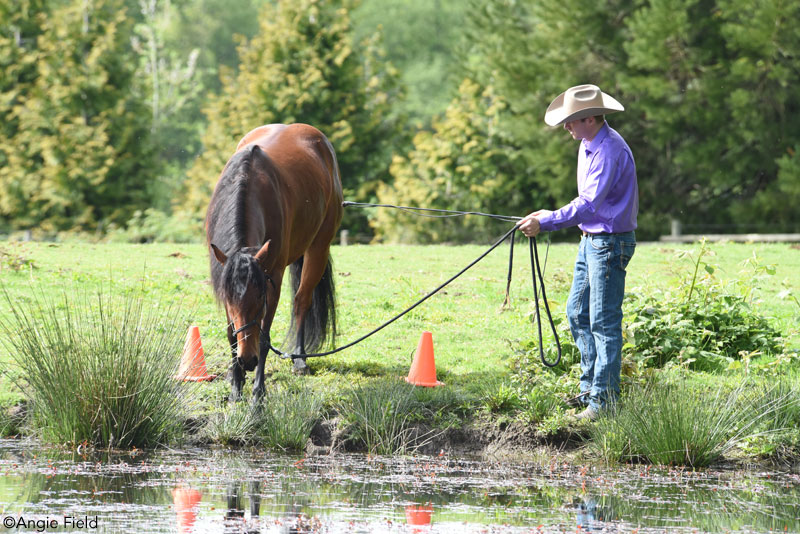
STEP 2: Ground Training with Introduction of Water
Introduce the horse to your man-made puddle or a very shallow natural water source, but be sure whatever you use has a good base. Avoid anything that is boggy or very muddy, as unsure footing will stress the horse and he may lunge for safer ground. Stand by the water’s edge and direct the horse forward toward the water. Never stand in the water and ask him to come toward you. The horse can panic and jump into you.
At this stage, you simply want the horse to be curious. If he paws at the water and splashes around, this will help build confidence and let him realize the water won’t hurt him. Allow him time to paw at it, sniff and back away. If during the first session you only get the front feet in, that’s OK. Do this several times over a week or so. If he goes right in, that’s great! Allow him to experience the water and hang out in it. That’s the goal at this point. Only after he’s totally comfortable with this stage should you progress to the next step.
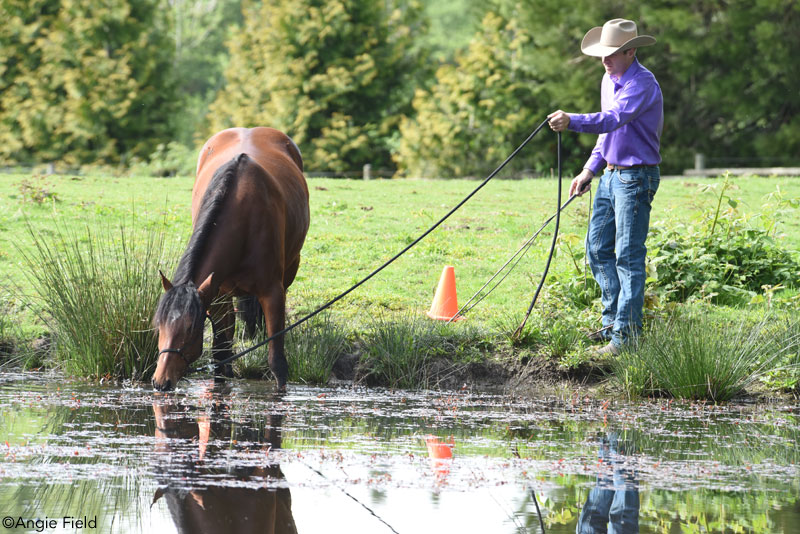
STEP 3: Ride Across Water
First, be sure there is a solid base under the shallow crossing. Field prefers a creek with an easy, gradual entry. Ride up to the water’s edge at a walk. Stand still for a minute or so with the horse facing the water. He may turn his head from side to side to get a better look, which is what you want. Let him assess it and then give a light squeeze with both legs, asking him to move forward.
If the horse is accustomed to being ridden with a riding crop, you can lightly tap him with it, but only if he doesn’t first respond to your leg cues.
Patience is key. Don’t immediately pressure the horse to get into the water. Too much pressure will shut down the learning mindset and put him into survival mode. He may bolt to the side, spin or make a flying leap into or across the water.
Keep him facing the water. Each time your horse looks toward it or even takes a tiny step forward, immediately release the pressure from your legs and/or crop.
“Make sure you release all pressure with the reins, too,” says Field. ” Allow him to consider what you’re asking of him. You might only rest him for a few seconds, then ask him to step again. If he backs up or steps to the side, keep light pressure on him with your legs until he starts to think forward or takes that 1-inch step forward.
“With challenges like this, people get hurried and apply too much pressure,” he adds. “Don’t escalate the pressure on a horse that is trying. He may not be trying in the right direction yet, but stepping to the side and moving around is still trying. Just hold that level of pressure until the horse takes the slightest step toward the water.”
If after about 10 minutes, the horse still won’t take even a 1-inch step toward the water, leave it. Do something else that requires quick, vigorous action, such as trotting or cantering circles.
Some horses get so worried about going into water that they build up nervous energy. You don’t want this energy to build to the point that the horse feels he has no choice but to take a huge leap forward into the water.
Taking a short break to trot or lope circles will cause the horse to move his feet and burn that energy.
“When you finish this high stimulation work, then you can rest your horse by the water,” says Field. “The goal is to show him there is comfort near and in the water.”
STEP 4: Create Comfort in the Water
Once your horse has begun to cross water, you want to teach him that water is a comfortable place to hang out. Field makes a point of training near water and standing in it whenever he gives the horse a few minutes to rest.
“To me that’s what water crossing and all other challenging situations with horses are about,” says Field. “We want to teach and train our horses in a way that earns this level of trust. Then, when we ask them to do something, there is no hesitation because they trust our judgment.”
Meet the Trainer
Jonathan Field named his horsemanship program Inspired by Horses™ because it was inspired with horses in mind at every step. The bulk of Field’s teaching is helping humans think the way horses think, with the ultimate goal of building a strong relationship.
He and his wife Angie and their sons, Weston and Mason, live in British Columbia, Canada. www.jonathanfield.net
This article originally appeared in the July 2015 issue of Horse Illustrated magazine. Click here to subscribe!


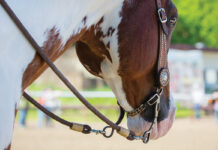
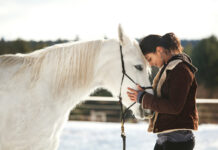
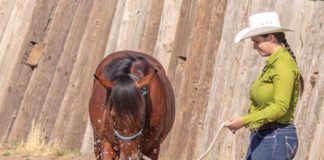

Good information, a link to the trainers website, which I am sure will if more information.